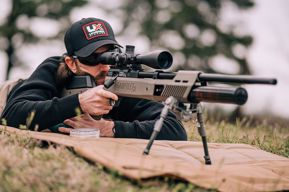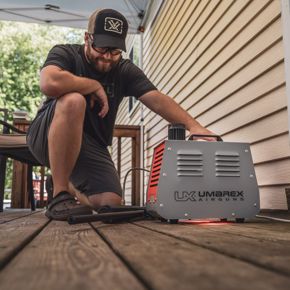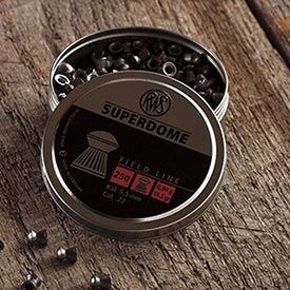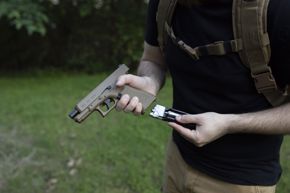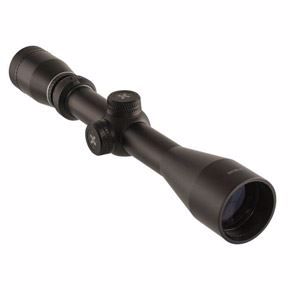Back in the dark ages, my father brought home a BB gun. It was a CO2 powered single-shot air pistol. I loved it but was only allowed to shoot it when we visited family that lived out in the sticks. And CO2 was a rare commodity. My father rationed those little steel tubes.
While I was in love with the accuracy and ease of operation, I was frustrated by how fast the gun ran dry. I’d always wanted a gun that could fire indefinitely. Forever. I knew they existed, but I didn’t have one (which may have been a parenting decision that backfired terribly—I mean, look at me now).
The Umarex Forge is really the most exquisite realization of those long lost childhood aspirations. It is the perfect blend of traditional aesthetics and modern technology. The break action design makes it ideal for those who want to shoot all day, without the hassle of CO2 or the clack-clack of a pump action air gun. And it performs incredibly well.
The Forge is an interesting hybrid. It is a gun that’s worthy of a scope, as the rifled barrel and T.N.T. piston deliver consistent accuracy. It combines the stability and long life of polymer and steel construction with the timeless lines of a wooden stock that’s made from sustainable materials.
The wooden stock itself is incredibly light. The checkering is sharp enough to provide a solid grip. The polymer portion of the frame allows for a very reliable and stable bedding that won’t be affected by humidity (or the lack thereof). The hardwood is naturally stable but can flex and move with changes in humidity without compromising the rifle’s performance. The combination is subtle, too. There’s no gratuitous angles or additions that so many designers tend to rely on to show everyone just-how-new their innovations are.
And it is a solid performer. The break action, after a full day on the range, began to feel like one of those torture machines I often avoid when I go to the gym, but it compresses air beautifully, and provided consistent velocity. The specs say it takes 30 pounds of pressure to cock the Forge. That results in velocities that averaged just under 1,100 FPS with RWS Superdome 8.3 grain pellets.
As for accuracy, the Forge is spot on. At 25 yards, I was popping the center spot on a Birchwood-Casey Shoot-n-See. From that distance, I could easily cover my groups with a quarter. I kept trying for a good one-hole, 5 shot group. I’d get close, and would inevitably have a flier that would land half an inch out.
I was shooting a .177 Forge, so longer distances open up. The winds here in Arkansas, which range from constant to drive-you-nuts this time of year, don’t do any favors for light pellets. Still, I have had no indications that the Forge wouldn’t be a solid one-hole gun at 25 yards, if placed in a rest under optimal conditions.
For me, though, that seems to miss the point. When I think of the ideal uses for a rifle like this, it has nothing to do with match-grade accuracy. This is an all-around plinker. This is a squirrel’s worst nightmare. And it would be hell on tin cans.
The speed at which you can shoot a rifle like this forces you to slow down, though, and aim each shot. That pace is rewarded by the accuracy, though, and well worth it.
The Nucleus Rail is another feature that makes the Forge user-friendly. The rail is built into the polymer frame housing that covers the piston. The scope sitting up top on this one is an Umarex 4x32. The fixed magnification is ideal for a rifle like this. At modest ranges, like the 25-yard bay where I was testing for accuracy, the scope makes placing shots child’s play. At longer ranges, the scope takes some of the guess-work out of accounting for the effects of the wind on light .177 pellets.
The Forge comes with the 4x32 scope, but it also has a two-color three-dot fiber optic sight system. The front bead is well protected, and the post is actually built onto the SilenceAir noise reducer. They work well, and the rear is adjustable.
I shot a variety of pellets through the Forge. My favorite field load, the RWS Superdomes, were clocking in just under 1,000 FPS. The average for a 10 shot string came in at 976.4 FPS.
To round it off, the Forge’s trigger is adjustable. Out of the box, this one broke at 6 pounds. While that’s a bit too high for clean target shooting, it is functional for plinking. And it is easy to adjust.
At the end of my range time with the Forge, I was impressed by what Umarex has done. This rifle has a true dedication to classic styling. That doesn’t mean it is old-fashioned. Not by a long shot. Don’t let the looks of this fool you. From the Nucleus rail and polymer frame, or the wood stock that houses it, this is one break action air gun that looks as good as it shoots.


